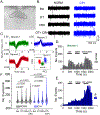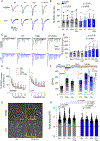Oxytocin and corticotropin-releasing hormone exaggerate nucleus tractus solitarii neuronal and synaptic activity following chronic intermittent hypoxia
- PMID: 38698722
- PMCID: PMC11251298
- DOI: 10.1113/JP286069
Oxytocin and corticotropin-releasing hormone exaggerate nucleus tractus solitarii neuronal and synaptic activity following chronic intermittent hypoxia
Abstract
Chronic intermittent hypoxia (CIH) in rodents mimics the hypoxia-induced elevation of blood pressure seen in individuals experiencing episodic breathing. The brainstem nucleus tractus solitarii (nTS) is the first site of visceral sensory afferent integration, and thus is critical for cardiorespiratory homeostasis and its adaptation during a variety of stressors. In addition, the paraventricular nucleus of the hypothalamus (PVN), in part through its nTS projections that contain oxytocin (OT) and/or corticotropin-releasing hormone (CRH), contributes to cardiorespiratory regulation. Within the nTS, these PVN-derived neuropeptides alter nTS activity and the cardiorespiratory response to hypoxia. Nevertheless, their contribution to nTS activity after CIH is not fully understood. We hypothesized that OT and CRH would increase nTS activity to a greater extent following CIH, and co-activation of OT+CRH receptors would further magnify nTS activity. Our data show that compared to their normoxic controls, 10 days' CIH exaggerated nTS discharge, excitatory synaptic currents and Ca2+ influx in response to CRH, which were further enhanced by the addition of OT. CIH increased the tonic functional contribution of CRH receptors, which occurred with elevation of mRNA and protein. Together, our data demonstrate that intermittent hypoxia exaggerates the expression and function of neuropeptides on nTS activity. KEY POINTS: Episodic breathing and chronic intermittent hypoxia (CIH) are associated with autonomic dysregulation, including elevated sympathetic nervous system activity. Altered nucleus tractus solitarii (nTS) activity contributes to this response. Neurons originating in the paraventricular nucleus (PVN), including those containing oxytocin (OT) and corticotropin-releasing hormone (CRH), project to the nTS, and modulate the cardiorespiratory system. Their role in CIH is unknown. In this study, we focused on OT and CRH individually and together on nTS activity from rats exposed to either CIH or normoxia control. We show that after CIH, CRH alone and with OT increased to a greater extent overall nTS discharge, neuronal calcium influx, synaptic transmission to second-order nTS neurons, and OT and CRH receptor expression. These results provide insights into the underlying circuits and mechanisms contributing to autonomic dysfunction during periods of episodic breathing.
Keywords: autonomic nervous system; hypoxia; neuronal activity; synaptic transmission.
© 2024 The Authors. The Journal of Physiology © 2024 The Physiological Society.
Conflict of interest statement
The authors declare no competing financial interests.
Figures








Similar articles
-
Hypoxia activates a neuropeptidergic pathway from the paraventricular nucleus of the hypothalamus to the nucleus tractus solitarii.Am J Physiol Regul Integr Comp Physiol. 2018 Dec 1;315(6):R1167-R1182. doi: 10.1152/ajpregu.00244.2018. Epub 2018 Sep 19. Am J Physiol Regul Integr Comp Physiol. 2018. PMID: 30230933 Free PMC article.
-
Vagotomy blunts cardiorespiratory responses to vagal afferent stimulation via pre- and postsynaptic effects in the nucleus tractus solitarii.J Physiol. 2024 Mar;602(6):1147-1174. doi: 10.1113/JP285854. Epub 2024 Feb 20. J Physiol. 2024. PMID: 38377124
-
Exaggerated potassium current reduction by oxytocin in visceral sensory neurons following chronic intermittent hypoxia.Auton Neurosci. 2020 Dec;229:102735. doi: 10.1016/j.autneu.2020.102735. Epub 2020 Sep 28. Auton Neurosci. 2020. PMID: 33032244 Free PMC article.
-
Reactive Oxidative Species in Carotid Body Chemoreception: Their Role in Oxygen Sensing and Cardiorespiratory Alterations Induced by Chronic Intermittent Hypoxia.Antioxidants (Basel). 2025 Jun 1;14(6):675. doi: 10.3390/antiox14060675. Antioxidants (Basel). 2025. PMID: 40563309 Free PMC article. Review.
-
Carotid body contribution to the physio-pathological consequences of intermittent hypoxia: role of nitro-oxidative stress and inflammation.J Physiol. 2023 Dec;601(24):5495-5507. doi: 10.1113/JP284112. Epub 2023 May 14. J Physiol. 2023. PMID: 37119020 Review.
Cited by
-
Cardiac vagal motor neurons.Curr Opin Neurobiol. 2025 Aug;93:103068. doi: 10.1016/j.conb.2025.103068. Epub 2025 Jun 25. Curr Opin Neurobiol. 2025. PMID: 40570503 Review.
References
-
- Barberis C, Audigier S, Durroux T, Elands J, Schmidt A & Jard S. (1992). Pharmacology of oxytocin and vasopressin receptors in the central and peripheral nervous system. Ann N Y Acad Sci 652, 39–45. - PubMed
MeSH terms
Substances
Grants and funding
LinkOut - more resources
Full Text Sources
Research Materials
Miscellaneous

